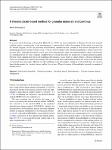Item Infomation
Full metadata record
| DC Field | Value | Language |
|---|---|---|
| dc.contributor.author | Göran, Frenning | - |
| dc.date.accessioned | 2023-05-25T04:35:34Z | - |
| dc.date.available | 2023-05-25T04:35:34Z | - |
| dc.date.issued | 2022 | - |
| dc.identifier.uri | https://link.springer.com/article/10.1007/s40571-022-00508-3 | - |
| dc.identifier.uri | https://dlib.phenikaa-uni.edu.vn/handle/PNK/8507 | - |
| dc.description | CC BY | vi |
| dc.description.abstract | In a recent article (Frenning in Comp Part Mech 24:1–4, 2021), we demonstrated that a Delaunay-based strain estimate could be used as a starting point for the development of a particle-based method for continua. In this article, we argue that the Voronoi diagram, dual to the previously used Delaunay tetrahedralization, provides a more natural description of the underlying particulate system. For this reason, a Voronoi-based estimate of the deformation gradient is derived and used to the same effect. Although the gradient vectors cease to be antisymmetric, sums over nearest neighbors vanish, which results in a formulation that not only is linearly complete but also satisfies the patch test irrespective of initial particle placement. Pairwise forces, inferred from the local (nonaffine) deformation of each bond or contact, impart a physical stabilization | vi |
| dc.language.iso | en | vi |
| dc.publisher | Springer | vi |
| dc.subject | Voronoi strain-based method | vi |
| dc.title | A Voronoi strain-based method for granular materials and continua | vi |
| dc.type | Book | vi |
| Appears in Collections | ||
| OER - Kỹ thuật điện; Điện tử - Viễn thông | ||
Files in This Item:

